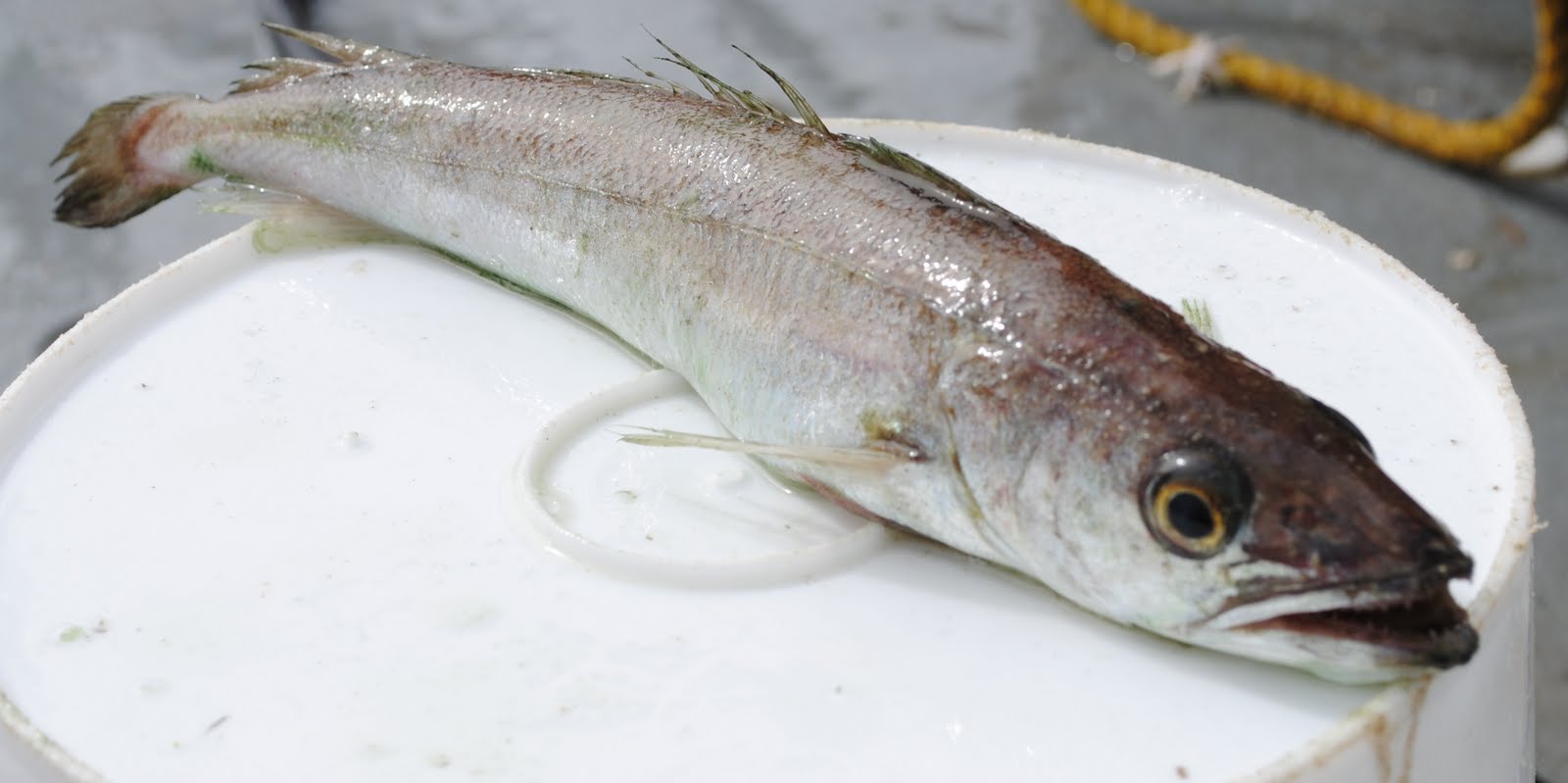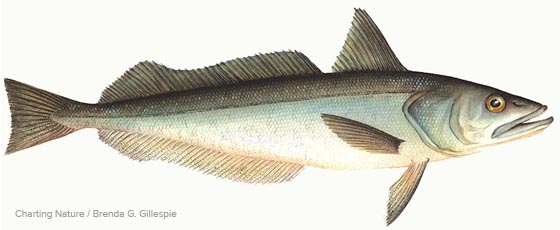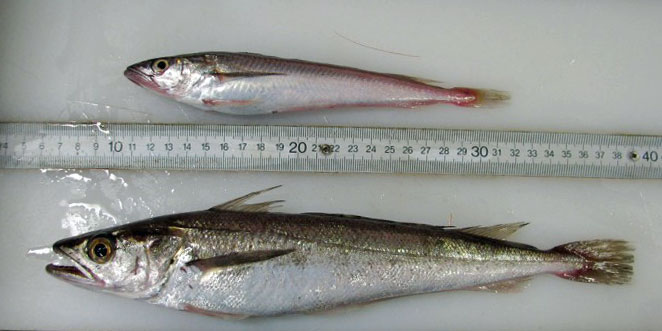
Merluccius bilinearis
FAMILY
Merlucciidae
TAXONOMY
Merluccius bilinearis Mitchill, 1814, New York.
OTHER COMMON NAMES
English: Atlantic whiting.
PHYSICAL CHARACTERISTICS
Genus (hakes) characterized by large head (1/3 to 1/4 of body
length), with large, oblique mouth. Lower jaw longer than upper.
Two separate dorsal fins, the first short based, high, and
triangular, separated from the second, which is long and partially
divided by a notch in the midsection. Single anal fin similar
in shape to second dorsal. Pelvic fins with seven rays.
Silver hake has 16–20 gill rakers on the first arch (cf. 8–11 in
closely related Merluccius albidus). Color purplish gray dorsally,
silvery white lower on sides.
DISTRIBUTION
Occurs on the continental shelf of the northwest Atlantic
Ocean from Gulf of St. Lawrence and Grand Banks to offings
of North Carolina. Silver hake are most abundant between
Nova Scotia and New Jersey. Two stocks have been identified
in American waters. One occurs in the Gulf of Maine and
northern edge of Georges Bank, the other from the southern
edge of Georges Bank to Cape Hatteras, North Carolina.
HABITAT
Silver hake apparently prefer temperatures between 44.6 and
51.8°F (7 and 11°C) in the summer and fall, and 44.6 and
55.4°F (7 and 13°C) in the spring. They occur in depths between
33 and 4,100 ft (10 and 1,250 m), moving into deeper
waters during the coldest time of year. Little is known about
substrates they prefer, although juveniles 0.6–2.0 in (1.5–5.0
cm) are most abundant on silt-sand bottoms with concentrations
of amphipod tubes. During the colder times of year, silver
hake become concentrated in deep basins of the Gulf of
Maine and along the upper continental slope.
BEHAVIOR
All stocks of silver hake exhibit inshore-offshore migrations associated
with temperature changes and availability of important
diet items. They are primarily demersal fish, but often move
upward in the water column, especially at night, presumably
following prey items.
FEEDING ECOLOGY AND DIET
Young silver hake <7.9 in (20 cm) eat mostly crustaceans, such
as euphausiids and shrimps. As they grow, they consume increasing
proportions of fishes, and adults >13.8 in (35 cm) feed
almost exclusively on fishes. Said to be a voracious predator,
their diet sometimes includes smaller silver hake.
REPRODUCTIVE BIOLOGY
Major spawning areas include coastal Gulf of Maine, southern
Georges Bank, and waters south of Rhode Island. In these areas
spawning reaches a peak in June and July. Spawning occurs
during late summer off Sable Island Bank in Canadian waters.
Females are asynchronous spawners and lay their eggs in several
batches through the season. Age and length at maturity
have both declined in recent years. In the early 1960s, silver
hake reached maturity at two to three years of age and lengths
between 11.4 and 13.0 in (29 and 33 cm). By 1989, these figures
had declined to 1.6–1.7 years old and 8.8–9.1 in
(22.3–23.2 cm), respectively. Another study found that 20% of
two-year-olds had reached maturity in 1973, while 80% of
two-year-olds had reached maturity in 1990.
CONSERVATION STATUS
Not listed by the IUCN. The decline in size and age at maturity
are usually the result of a stock that has been overfished. In both
the northern and southern stocks, significant mortality of juvenile
silver hake has occurred through discarding in the large
mesh and small mesh otter trawl fisheries directed at other
species. Annual discard estimates over 1989–1992 ranged from
1,430–11,020 tn (1,300–10,000 t [10 million to 81 million fish])
per year. Excessive discard mortality on juveniles may severely
limit opportunities to rebuild either silver hake stock. The
southern stock is considered to be in an overfished condition.
SIGNIFICANCE TO HUMANS
The silver hake fishery is important to the United States, Russia,
and Cuba. Centers of the fishery are Nova Scotia, Gulf of
Maine, and Georges Bank. The total catch in 1987 was 85,950
tn (77,975 t), down from 479,500 tn (435,000 t) in 1973. Silver
hake flesh is flaky and good tasting. It is marketed frozen or
filleted, and preparation methods include smoking, boiling, and
frying.
Photo Gallery of - Silver hake





 Animalia Life
Animalia Life